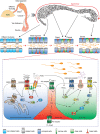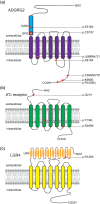Function and therapeutic potential of G protein-coupled receptors in epididymis
- PMID: 32901914
- PMCID: PMC7707088
- DOI: 10.1111/bph.15252
Function and therapeutic potential of G protein-coupled receptors in epididymis
Abstract
Infertility rates for both females and males have increased continuously in recent years. Currently, effective treatments for male infertility with defined mechanisms or targets are still lacking. G protein-coupled receptors (GPCRs) are the largest class of drug targets, but their functions and the implications for the therapeutic development for male infertility largely remain elusive. Nevertheless, recent studies have shown that several members of the GPCR superfamily play crucial roles in the maintenance of ion-water homeostasis of the epididymis, development of the efferent ductules, formation of the blood-epididymal barrier and maturation of sperm. Knowledge of the functions, genetic variations and working mechanisms of such GPCRs, along with the drugs and ligands relevant to their specific functions, provide future directions and a great arsenal for new developments in the treatment of male infertility.
Keywords: ADGRG2; AT2 receptor; G protein-coupled receptor (GPCR); LGR4; epididymis; male infertility.
© 2020 The British Pharmacological Society.
Conflict of interest statement
The authors declare no conflicts of interests.
Figures


Similar articles
-
G-Protein Coupled Receptors in Human Sperm: An In Silico Approach to Identify Potential Modulatory Targets.Molecules. 2022 Oct 1;27(19):6503. doi: 10.3390/molecules27196503. Molecules. 2022. PMID: 36235040 Free PMC article.
-
LGR4 regulates the postnatal development and integrity of male reproductive tracts in mice.Biol Reprod. 2007 Feb;76(2):303-13. doi: 10.1095/biolreprod.106.054619. Epub 2006 Nov 1. Biol Reprod. 2007. PMID: 17079737
-
Adhesion G protein-coupled receptor G2 is dispensable for lumicrine signaling regulating epididymal initial segment differentiation and gene expression†.Biol Reprod. 2023 Oct 13;109(4):474-481. doi: 10.1093/biolre/ioad087. Biol Reprod. 2023. PMID: 37531264 Free PMC article.
-
Estrogen and its receptors in efferent ductules and epididymis.J Androl. 2011 Nov-Dec;32(6):600-13. doi: 10.2164/jandrol.110.012872. Epub 2011 Mar 25. J Androl. 2011. PMID: 21441425 Review.
-
Role of epididymal receptor HE6 in the regulation of sperm microenvironment.Mol Cell Endocrinol. 2006 May 16;250(1-2):43-8. doi: 10.1016/j.mce.2005.12.023. Epub 2006 Jan 18. Mol Cell Endocrinol. 2006. PMID: 16413110 Review.
Cited by
-
Activation of PTH1R alleviates epididymitis and orchitis through Gq and β-arrestin-1 pathways.Proc Natl Acad Sci U S A. 2021 Nov 9;118(45):e2107363118. doi: 10.1073/pnas.2107363118. Proc Natl Acad Sci U S A. 2021. PMID: 34740971 Free PMC article.
-
Seminal plasma protein profiles and testosterone levels as biomarker semen quality of candidate Madura bulls.J Adv Vet Anim Res. 2023 Sep 24;10(3):429-436. doi: 10.5455/javar.2023.j696. eCollection 2023 Sep. J Adv Vet Anim Res. 2023. PMID: 37969800 Free PMC article.
-
A novel ADGRG2 truncating variant associated with X-linked obstructive azoospermia in a large Chinese pedigree.J Assist Reprod Genet. 2023 Jul;40(7):1747-1754. doi: 10.1007/s10815-023-02839-3. Epub 2023 Jun 5. J Assist Reprod Genet. 2023. PMID: 37273165 Free PMC article.
-
Functional Characterization of the Obesity-Linked Variant of the β3-Adrenergic Receptor.Int J Mol Sci. 2021 May 27;22(11):5721. doi: 10.3390/ijms22115721. Int J Mol Sci. 2021. PMID: 34072007 Free PMC article.
-
Tethered peptide activation mechanism of the adhesion GPCRs ADGRG2 and ADGRG4.Nature. 2022 Apr;604(7907):771-778. doi: 10.1038/s41586-022-04590-8. Epub 2022 Apr 13. Nature. 2022. PMID: 35418677
References
Publication types
MeSH terms
Substances
Grants and funding
LinkOut - more resources
Full Text Sources
Other Literature Sources
Medical

